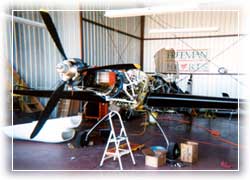
The legendary Sukhoi 26 mx has undergone
several alterations. Last year the airplane was equipped with Full IFR capabilities.
(Instrument flying in bad weather and at night)
In the Fall of 2000, the regular Radical Engine was removed and the airplane is
about to take off with a 740 HP Walter M601T Turbo-Prop (Jet Turbine). THIS WILL
GIVE THIS AIRPLANE MORE THAN 2 TIMES THE POWER.
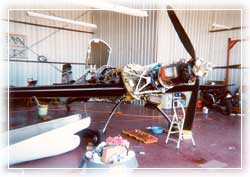
WORK IN PROGRESS OF THE
JET TURBINE CONVERSION
The team involved in this existing
conversion process are…

Les Shockley, Owner of the Shockwave Jet Truck. He is the inventor of many
jet applications including Jimmy Franklin's Jet WACO. He has installed the Turbine
and powered the Fuel injection system.
John Brown, Owner of Mizzou
Aviation and sponsor of this airplane. He is the main driving force for accurate
weight and balance calibrations.
Tim Forker, Chief Mechanic
of Mizzou Aviation. He has worked and works on all areas of the airplane.
Ron Coit, Our wire and electronics
guy.
Lubac & Peter, From Walter
Engines in the Chek Republic for safety issues and timing of the power system on
location at the Joplin
Regional Airport.
Stephen Wade, From Oasis Carwash Manufacturing. He conducts aluminum work
and also engineering.
Dale Coffey, DC Trucking. Dale does
and continues to work on all the systems of the aircraft.
History of Sukhoi 26MX
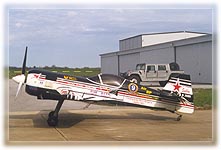 The Eastern block countries used to dominate the aerobatics world championship.
However, in the mid 80's the competition from the Western countries arose and the
Russians did not do as well as they used to in their Yak 50 at that time. The Russian
government did not want to allow this to happen and therefore it decided to go to
the military airplane designer Sukhoi to design a new revolutionizing aerobatics
plane. The engineers of the Sukhoi factory just outside of Moscow designed the aerobatical
design off the Sukhoi 26 MX. The airplane was designed in order to withstand higher
G-load than the competing airplanes as well as to increase its instability to allow
a faster roll rate and also a more brisk stall characteristic. They came up with
the Sukhoi 26 MX, an airplane wing built out of keflar and titanium to withstand
G-forces up to 24 G's and an airplane frame that would withhold plus/minus 12 G's
on a regular basis. A Vandenyew MP 14 radial engine was to provide thrust for this
airplane. The engine is supercharged with a supercharger that will charge from sea
level to 4000 feet altitude and geared close to 1:2. This allowed to put an over-sized
propeller on the aircraft for increased efficiency and better thrust profile. The
airplane is built very robust with a reclined seat in order to tolerate the G-forces
better like the F16 has. Of note, the propeller turns the opposing way compared
to all the Western aircraft's. This airplane is not the fastest airplane and also
not the lightest airplane, but the engineers definitely seceded in building a very
unstable airplane that is very strongly build. When Sukhoi released the aircraft
for the Russian competing pilots
The Eastern block countries used to dominate the aerobatics world championship.
However, in the mid 80's the competition from the Western countries arose and the
Russians did not do as well as they used to in their Yak 50 at that time. The Russian
government did not want to allow this to happen and therefore it decided to go to
the military airplane designer Sukhoi to design a new revolutionizing aerobatics
plane. The engineers of the Sukhoi factory just outside of Moscow designed the aerobatical
design off the Sukhoi 26 MX. The airplane was designed in order to withstand higher
G-load than the competing airplanes as well as to increase its instability to allow
a faster roll rate and also a more brisk stall characteristic. They came up with
the Sukhoi 26 MX, an airplane wing built out of keflar and titanium to withstand
G-forces up to 24 G's and an airplane frame that would withhold plus/minus 12 G's
on a regular basis. A Vandenyew MP 14 radial engine was to provide thrust for this
airplane. The engine is supercharged with a supercharger that will charge from sea
level to 4000 feet altitude and geared close to 1:2. This allowed to put an over-sized
propeller on the aircraft for increased efficiency and better thrust profile. The
airplane is built very robust with a reclined seat in order to tolerate the G-forces
better like the F16 has. Of note, the propeller turns the opposing way compared
to all the Western aircraft's. This airplane is not the fastest airplane and also
not the lightest airplane, but the engineers definitely seceded in building a very
unstable airplane that is very strongly build. When Sukhoi released the aircraft
for the Russian competing pilots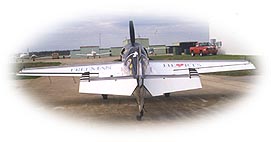 to fly it, not everybody was capable to adjust to this radical design. It was named
to be an engineer's airplane and not a pilot's airplane. The switch-over from a
Western aircraft design to this Sukhoi 26 MX, is that it takes about 100 hours of
aerobatics practice time in order to regain the level of competency. The Sukhoi
31 MX is the new design that came out with pilot's input. A few changes were carried
out and it became a more pilot friendly airplane. The Sukhoi 26 MX is flown very
aggressively and very brutally. It is a true workout. The pilot might lose about
four pounds of weight during flight and has probably the highest G exposure compared
to all the other aerobatics aircrafts.
to fly it, not everybody was capable to adjust to this radical design. It was named
to be an engineer's airplane and not a pilot's airplane. The switch-over from a
Western aircraft design to this Sukhoi 26 MX, is that it takes about 100 hours of
aerobatics practice time in order to regain the level of competency. The Sukhoi
31 MX is the new design that came out with pilot's input. A few changes were carried
out and it became a more pilot friendly airplane. The Sukhoi 26 MX is flown very
aggressively and very brutally. It is a true workout. The pilot might lose about
four pounds of weight during flight and has probably the highest G exposure compared
to all the other aerobatics aircrafts.
Since the Sukhoi 26 MX has been released, the Eastern block pilots
have regained world title and have brought the level of aerobatics flying to new
territory.
The Joplin Project started out with changing the VFR airplane to a
IFR platform, then the regular radial engine was replaced by a jet turbine power
unit to increase the regular 360HP to 740HP. With this power to weight ratio the
well established book of aerobatics flying has been closed and a new book for the
future has been started.
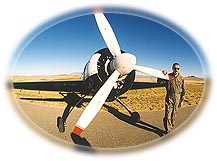 Ray Vetsch flies the Russian Sukhoi 26MX, Sponsored by
Freeman Heart Hospital in Joplin, Missouri.
Ray Vetsch flies the Russian Sukhoi 26MX, Sponsored by
Freeman Heart Hospital in Joplin, Missouri. This airplane was built in 1990, has
a fiberglass keflar wing with titanium reinforcements, as well as a titanium gear
and is powered with a Walter M601T Jet Turbine Prop, 740HP. The wing is tested to
24G's plus or minus and if you look at the wing, you see that it is a fully symmetric
wing with a very deep cord which allows for a maximal performance. This airplane
is basically built not for speed but for strength.
This is a one of a kind aiplane and there is nothing comparible in all of the world.
It is the most powerful weight/thrust ratio propeller airplane worldwide... The
Joplin Project.